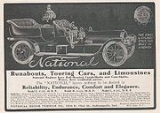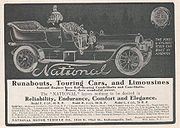
National Motor Vehicle
Encyclopedia
The National Motor Vehicle Company was an American
manufacturer of automobile
s in Indianapolis, Indiana
between 1900 and 1924. Its president, Arthur C. Newby, was one of the investors who created the Indianapolis Motor Speedway
.
The company first concentrated on electric vehicle
s, making their first one, a runabout
with tiller
steering called the Style A, in 1900. They moved into internal combustion-engined cars in 1903 with two- and four-cylinder models, both using engines made for them by Rutenber
.
model. It sold for US$2000. The single electric motor was situated at the rear of the car, producing 9 hp
(6.7 kW). A 4-speed herring bone transmission
was fitted. The armored wood-framed car could reach 15 mph (24 km/h).
For 1905, the two-cylinder model was dropped and a six-cylinder car with a circular radiator
took its place. The last electric cars were made in 1906, and in 1907, National starting building its own engines.
Peak production for National was reached in 1915 with over 1,800 cars made. The company changed its name in 1916 to the National Motor and Vehicle Company, and in 1922 became, along with Dixie Flyer
and Jackson
, part of the Associated Motor Industries group. However, sales dropped in the early 1920s and the company closed in 1924.

won the Indianapolis 500
in a National.
United States
The United States of America is a federal constitutional republic comprising fifty states and a federal district...
manufacturer of automobile
Automobile
An automobile, autocar, motor car or car is a wheeled motor vehicle used for transporting passengers, which also carries its own engine or motor...
s in Indianapolis, Indiana
Indianapolis, Indiana
Indianapolis is the capital of the U.S. state of Indiana, and the county seat of Marion County, Indiana. As of the 2010 United States Census, the city's population is 839,489. It is by far Indiana's largest city and, as of the 2010 U.S...
between 1900 and 1924. Its president, Arthur C. Newby, was one of the investors who created the Indianapolis Motor Speedway
Indianapolis Motor Speedway
The Indianapolis Motor Speedway, located in Speedway, Indiana in the United States, is the home of the Indianapolis 500-Mile Race and the Brickyard 400....
.
The company first concentrated on electric vehicle
Electric vehicle
An electric vehicle , also referred to as an electric drive vehicle, uses one or more electric motors or traction motors for propulsion...
s, making their first one, a runabout
Runabout (car)
Runabouts were a popular car body style at the beginning of the 20th Century. They were small, inexpensive, open cars. Most runabouts had just a single row of seats, providing seating for two passengers. Many also had a tonneau at the rear to provide optional seating for four or five...
with tiller
Tiller
A tiller or till is a lever attached to a rudder post or rudder stock of a boat that provides leverage for the helmsman to turn the rudder...
steering called the Style A, in 1900. They moved into internal combustion-engined cars in 1903 with two- and four-cylinder models, both using engines made for them by Rutenber
Rutenber Motor Company
The Rutenber Motor Company was established as the Rutenber Manufacturing Company in Chicago, Illinois, USA, to manufacture a four-cylinder engine to the design of Edwin Rutenber....
.
Production models
The 1904 National Tonneau was a tonneauTonneau
right|thumb|260px|1903 [[Ford Model A |Ford Model A]] rear-door TonneauTonneau cover , describes a hard or soft cover used to protect unoccupied passenger seats in a convertible, roadster, or for a pickup truck bed. Hard tonneau covers open by a hinging or folding mechanism while soft covers open...
model. It sold for US$2000. The single electric motor was situated at the rear of the car, producing 9 hp
Horsepower
Horsepower is the name of several units of measurement of power. The most common definitions equal between 735.5 and 750 watts.Horsepower was originally defined to compare the output of steam engines with the power of draft horses in continuous operation. The unit was widely adopted to measure the...
(6.7 kW). A 4-speed herring bone transmission
Transmission (mechanics)
A machine consists of a power source and a power transmission system, which provides controlled application of the power. Merriam-Webster defines transmission as: an assembly of parts including the speed-changing gears and the propeller shaft by which the power is transmitted from an engine to a...
was fitted. The armored wood-framed car could reach 15 mph (24 km/h).
For 1905, the two-cylinder model was dropped and a six-cylinder car with a circular radiator
Radiator
Radiators are heat exchangers used to transfer thermal energy from one medium to another for the purpose of cooling and heating. The majority of radiators are constructed to function in automobiles, buildings, and electronics...
took its place. The last electric cars were made in 1906, and in 1907, National starting building its own engines.
Peak production for National was reached in 1915 with over 1,800 cars made. The company changed its name in 1916 to the National Motor and Vehicle Company, and in 1922 became, along with Dixie Flyer
Dixie Flyer (automobile)
The Dixie Flyer was a vintage car built in Louisville, Kentucky from 1916 until 1923. Dixie Flyers were marketed under the slogan of "The Logical Car."...
and Jackson
Jackson Automobile Company
Jackson Automobile Company was a brass era auto manufacturer that produced the Jackson from 1903 to 1923, as well as the Jaxon steam car during 1903, and the Orlo only in 1904. All these cars were produced in Jackson, Michigan.-Company Background:...
, part of the Associated Motor Industries group. However, sales dropped in the early 1920s and the company closed in 1924.

Sporting success
In 1912, Joe DawsonJoe Dawson (racecar driver)
Joe Dawson was an American race car driver.-Biography:Born in Odon, Indiana, Dawson competed in the Indianapolis 500 race three times, beginning in 1911 when he drove a Marmon to a fifth place finish. The following year, Dawson won after Ralph DePalma, who had led for 196 laps of the 200 lap race,...
won the Indianapolis 500
Indianapolis 500
The Indianapolis 500-Mile Race, also known as the Indianapolis 500, the 500 Miles at Indianapolis, the Indy 500 or The 500, is an American automobile race, held annually, typically on the last weekend in May at the Indianapolis Motor Speedway in Speedway, Indiana...
in a National.
Advertisements
 |
Sources
- Frank Leslie's Popular Monthly (January, 1904)
- Clymer, Floyd. Treasury of Early American Automobiles, 1877-1925. New York: Bonanza Books, 1950.

